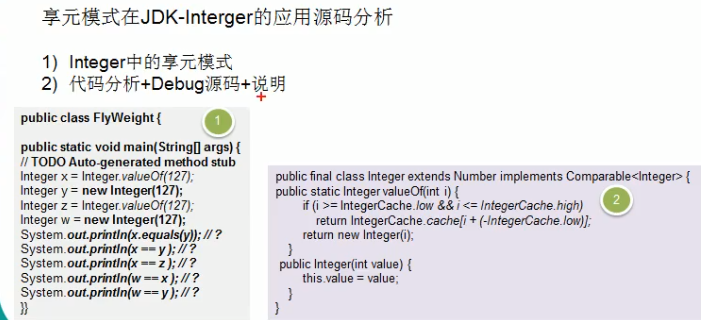享元模式在
package com.atguigu.jdk;
public class FlyWeight {
public static void main(String[] args) {
// TODO
Integer x = Integer.valueOf(127);
Integer y = new Integer(127);
Integer z = Integer.valueOf(127);
Integer w = new Integer(127);
System.out.println(x.equals(y)); // true
System.out.println(x == y); // false
System.out.println(x == z); // true
System.out.println(w == x); // false
System.out.println(w == y); // false
}
}
/**
* Returns an {@code Integer} instance representing the specified
* {@code int} value. If a new {@code Integer} instance is not
* required, this method should generally be used in preference to
* the constructor {@link #Integer(int)}, as this method is likely
* to yield significantly better space and time performance by
* caching frequently requested values.
*
* This method will always cache values in the range -128 to 127,
* inclusive, and may cache other values outside of this range.
*
* @param i an {@code int} value.
* @return an {@code Integer} instance representing {@code i}.
* @since 1.5
*/
public static Integer valueOf(int i) {
if (i >= IntegerCache.low && i <= IntegerCache.high)
// 这个范围是 刚好是 127 这里的范围和Python是保持一致的
return IntegerCache.cache[i + (-IntegerCache.low)];
return new Integer(i);
}
/**
* Cache to support the object identity semantics of autoboxing for values between
* -128 and 127 (inclusive) as required by JLS.
*
* The cache is initialized on first usage. The size of the cache
* may be controlled by the {@code -XX:AutoBoxCacheMax=<size>} option.
* During VM initialization, java.lang.Integer.IntegerCache.high property
* may be set and saved in the private system properties in the
* sun.misc.VM class.
*/
private static class IntegerCache {
static final int low = -128;
static final int high;
static final Integer cache[];
static {
// high value may be configured by property
int h = 127;
String integerCacheHighPropValue =
sun.misc.VM.getSavedProperty("java.lang.Integer.IntegerCache.high");
if (integerCacheHighPropValue != null) {
try {
int i = parseInt(integerCacheHighPropValue);
i = Math.max(i, 127);
// Maximum array size is Integer.MAX_VALUE
h = Math.min(i, Integer.MAX_VALUE - (-low) -1);
} catch( NumberFormatException nfe) {
// If the property cannot be parsed into an int, ignore it.
}
}
high = h;
cache = new Integer[(high - low) + 1];
int j = low;
for(int k = 0; k < cache.length; k++)
cache[k] = new Integer(j++);
// range [-128, 127] must be interned (JLS7 5.1.7)
assert IntegerCache.high >= 127;
}
private IntegerCache() {}
}
这里面有点儿像内个 python中的 对象 内存优化 的通过(引用)定义
实践出真知
package com.atguigu.jdk;
public class FlyWeight {
public static void main(String[] args) {
// TODO
// 如果Integer.valueOf(x) x 在-127---128之间,就是使用享元模式返回
// ,也就是说,要是有就返回,没有再创建
Integer x = Integer.valueOf(127);
Integer y = new Integer(127);
Integer z = Integer.valueOf(127);
Integer w = new Integer(127);
System.out.println(x.equals(y)); // true
System.out.println(x == y); // false
System.out.println(x == z); // true
System.out.println(w == x); // false
System.out.println(w == y); // false
Integer x1 = Integer.valueOf(200);
Integer x2 = Integer.valueOf(200);
System.out.println("x1==x2:"+(x1==x2));
/*
true
false
true
false
false
x1==x2:false
Process finished with exit code 0
* */
}
}
小结
- 在valueOf方法中,先判断值是否在IntegerCache 中, 如果不在,就创建新的Integer(new), 否则,就直接从缓存池中返回
- valueOf方法 ,就使用到了 这个 享元模式.


